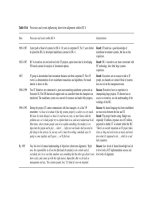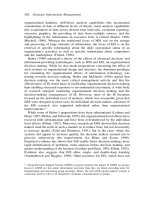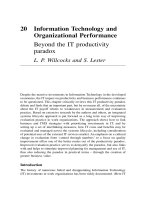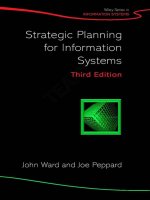Managing information systems 7th edition brow ch08
Bạn đang xem bản rút gọn của tài liệu. Xem và tải ngay bản đầy đủ của tài liệu tại đây (1.08 MB, 45 trang )
MANAGEMENT INFORMATION SYSTEMS
CHAPTER 8
BASIC SYSTEMS CONCEPTS AND TOOLS
AGENDA
• The Systems View
• Business Processes
• Systems Development Life Cycle and Structured Techniques
• Information Systems Controls
Copyright © 2011 Pearson Education, Inc. publishing as Prentice
THE SYSTEMS VIEW
What is a system?
• System: A set of interrelated components that must work
together to achieve some common purpose
Information System: The collection of IT, procedures, and
people responsible for the capture, movement, management, and
distribution of data and information
Copyright © 2011 Pearson Education, Inc. publishing as Prentice
THE SYSTEMS VIEW
• The term “System” is used to refer to something broader than an
information system:
• Systems thinking is:
- A discipline for seeing wholes
- A framework for seeing interrelationships rather than things
- An antidote to feeling of helplessness when dealing with
complexity
• A systems perspective is useful for understanding the relationships
among business units and organizational events.
Copyright © 2011 Pearson Education, Inc. publishing as Prentice
THE SYSTEMS VIEW
• Each piece needs to be well-designed, but the pieces also need
to work well together
Copyright © 2011 Pearson Education, Inc. publishing as Prentice
THE SYSTEMS VIEW
Seven key system elements:
1.
2.
3.
4.
5.
6.
7.
Boundary
Environment
Inputs
Outputs
Components
Interfaces
Storage
Copyright © 2011 Pearson Education, Inc. publishing as Prentice
SEVEN KEY SYSTEM ELEMENTS
1. BOUNDARY
•. Delineation of which elements are within the system and which
are outside
•. Where to draw the boundary depends on:
- What can be controlled
- What scope is manageable within a given time frame
- The impact of a boundary change
Copyright © 2011 Pearson Education, Inc. publishing as Prentice
SEVEN KEY SYSTEM ELEMENTS
2. ENVIRONMENT
• Everything outside the system
.
Copyright © 2011 Pearson Education, Inc. publishing as Prentice
SEVEN KEY SYSTEM ELEMENTS
.
3. INPUTS
Resources from the environment that are consumed and
manipulated within the system
4. OUTPUTS
Resources or products provided to the environment by the
activities within the system
Copyright © 2011 Pearson Education, Inc. publishing as Prentice
SEVEN KEY SYSTEM ELEMENTS
5. COMPONENTS
• Activities or processes within the system that transform
inputs into intermediate forms or that generate system outputs
• Some system components can be viewed as systems with
their own sets of interrelated components = subsystems
Copyright © 2011 Pearson Education, Inc. publishing as Prentice
SEVEN KEY SYSTEM ELEMENTS
6. INTERFACES
The place where two components or the system and its
environment meet or interact
7. STORAGE
Holding areas used for the temporary and permanent storage of
information, energy, materials, etc.
Copyright © 2011 Pearson Education, Inc. publishing as Prentice
KEY SYSTEM ELEMENTS :
PAYROLL EXAMPLE
Copyright © 2011 Pearson Education, Inc. publishing as Prentice
COMPONENT DECOMPOSITION
Sales Summary System
Produce Sales Summary Subsystem
Copyright © 2011 Pearson Education, Inc. publishing as Prentice
COMPONENT DECOMPOSITION
• Hierarchical decomposition: the process of breaking a system
down into successive levels of subsystems
• Goals of hierarchical decomposition:
- Cope with system complexity
- Analyze or change only part of the system
- Design and build each subsystem at different times
- Direct the attention of a target audience
- Allow components to operate more independently
Copyright © 2011 Pearson Education, Inc. publishing as Prentice
INTERFACES
Functions of Interfaces include:
- Filtering
- Disposing of useless data (or noise)
- Coding/decoding
- Translating data from one
format into another
- Error detection and correction
- Checking for compliance
to standards and for
consistency
- Buffer
- Allowing two subsystems to
work together without being
tightly synchronized
- Security
- Rejecting unauthorized requests
for data and providing other
protection mechanisms
- Summarizing
- Condensing large volumes of
input to reduce the amount of
work needed by subsequent
subsystems
Copyright © 2011 Pearson Education, Inc. publishing as Prentice
THE SYSTEMS VIEW
Organizations as systems
• One useful framework for examining how information systems
fit into organizational systems is based on the Leavitt diamond
• Four fundamental components in an organization:
Copyright © 2011 Pearson Education, Inc. publishing as Prentice
THE SYSTEMS VIEW
• Leavitt Diamond tells us that:
• If one component is changed, the others will likely be
affected as well
• Example: New software
- Business processes need to be redesigned
- Organizational structures might need to be modified
- People have to be trained
Copyright © 2011 Pearson Education, Inc. publishing as Prentice
SYSTEMS ANALYSIS AND DESIGN (SA&D)
Five Key Design Principles for Information Systems
• Two principles stem from key systems characteristics:
1. Choose an appropriate scope
- Selecting the boundary for the IS greatly influences
complexity and success of the project
2. Logical before physical
- You must know what an IS is to do before you can specify how
a system is to operate
Copyright © 2011 Pearson Education, Inc. publishing as Prentice
SYSTEMS ANALYSIS AND DESIGN (SA+D)
•
Three principles are problem-solving steps:
3. A problem is actually a set of problems and an
appropriate strategy is to keep breaking down a problem
into smaller, more manageable problems
4. A single solution is not usually obvious to all
stakeholders, so alternative solutions representing all
parties should be generated before a final solution is
selected
5. The problem and your understanding of it could change,
so a staged approach that incorporates reassessments and
incremental commitment to a solution is best
Copyright © 2011 Pearson Education, Inc. publishing as Prentice
BUSINESS PROCESSES
• Beginning in the early 1990s many organizations changed from a
more functional approach to a more process-oriented approach to
better compete
Business Process: Chain of activities required to achieve an
outcome -- such as order fulfillment or materials acquisition
Copyright © 2011 Pearson Education, Inc. publishing as Prentice
BUSINESS PROCESSES
• Business Process gurus in the early 1990s urged companies to
radically change the way they did business -- by starting with a
“clean slate” and utilizing information technology
Hammer, Michael. 1990. “Reengineering work: Don’t automate, obliterate.”
Harvard Business Review 68 (July-August): 104-112
Copyright © 2011 Pearson Education, Inc. publishing as Prentice
BUSINESS PROCESS REENGINEERING (BPR)
Business Process Reengineering (BPR): Radical business redesign
initiatives that attempt to achieve dramatic improvements in business
processes by questioning the assumptions, or business rules, that
underlie the organization’s structures and procedures
Copyright © 2011 Pearson Education, Inc. publishing as Prentice
EARLY BPR EXAMPLES
• Accounts Payable at Ford Motor Company
- 75% improvement gains after assumptions were
questioned and a reengineered solution was identified
• Mutual Benefit Life Insurance
- Changed a process that involved 19 people in five departments
so that it could be accomplished by one person
- Time to issue a policy decreased from 3 weeks to 3
hours
Copyright © 2011 Pearson Education, Inc. publishing as Prentice
EVALUATING BUSINESS PROCESSES
Copyright © 2011 Pearson Education, Inc. publishing as Prentice
HAMMER’S 6 PRINCIPLES FOR BPR
.
Hammer 1990
Copyright © 2011 Pearson Education, Inc. publishing as Prentice









